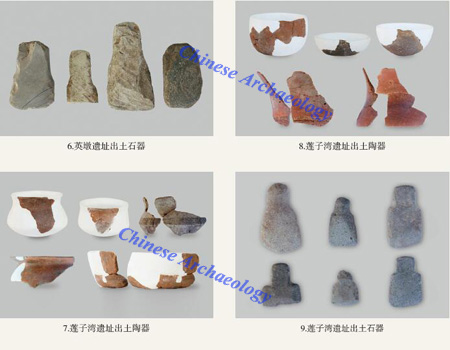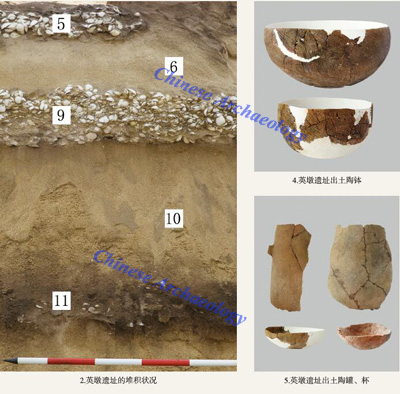Important Neolithic discoveries in southwest coastal areas in Hainan Island
From:Chinese Archaeology NetWriter:Date:2016-01-20
Archaeological survey in Hainan Island has been conducted jointly by Institute of Archaeology, Chinese Academy of Social Sciences and Hainan Provincial Museum (Hainan Provincial Institute of Cultural Relics and Archaeology) since March, 2012. Three sites including Qiaoshan, Lianziwan in Lingshui County and Yingdun site in Sanya City have been excavated since December, 2012. Besides, more than 30 sites including Gangshan and Zoufeng in Lingshui have been discovered by archaeological survey of coastal areas ranging from Wanning, Lingshui to Sanya (3 counties).
Aerial photo of Yingdun site(left)
Pottery unearthed from Yingdun site(right)

Potteries and stonewares unearthed from the Yingdun site and Lianziwan site

stratification of Yingdun site(left)
Potteries unearthed from Yingdun site(right)
Yingdun site is located at about 1.5 km east of Jianglin Village, Haitang District, Sanya City. It is about 300m long from south to north and 50m wide from west to east, covering an area of about 15000 square meters. Rich shell deposits were found in Yingdun site and plenty of artifacts were unearthed. The deposits of the site can be roughly divided into two phases, the Early period and the Late period. There are mainly coarse-sand-tempered and plate-shaped fu-cauldrons with a flat base as well as fine-sand-tempered jars, bowls with a slightly close mouth, cups and so on in the Early period deposits. Among them, the plate-shaped fu-cauldrons with a flat base have a relatively large size with an about 40cm diameter generally, which is also the most characteristic artifacts among Yingdun cultural remains. The surfaces of most of this kind of vessels were discovered smoked traces. Therefore they are supposed to be cooking vessels. Besides, there are stone tools with shoulders and bone artifacts and so on. Burnished and red-coated pottery shards were unearthed from Late period deposits. They have relatively hard body and high-fire and are finely polished. The recognizable shapes contain jars with curved rim and so on.
Lianziwan site is situated at about 3.5 km southwest of Dadun Village, Li’an Town, Lingshui County. Rich artifacts were uncovered from the site. There are two kinds of pottery, including brown coarse-sand-tempered pottery and burnished clay pottery. The bodies of the former ones are rather thick, most of which are plate-shaped fu-vessels with a flat base. While, burnished clay pottery has relatively thin bodies, and there are jars with folded rim, jars with curved rim, zun-vessels, bowls with a slightly close mouth and bowls and etc. In addition, there are lots of stone tools with shoulders and plenty of land and aquatic animal bones found.

Aerial photo of Qiaoshan site

Potteries,stonewares and spindle whorls unearthed from the Qiaoshan site
Qiaoshan site is located at about 2km north from Tonghai Village, Xincun Town, Lingshui County, covering an area of roughly 50000 square meters. With well-preserved state, Qiaoshan site is one of the biggest prehistoric sites discovered so far in Hainan region. Its rich deposits and artifacts are quite rare in the whole South China. The deposits can be divided into 3 levels. Cultural remains were intensively distributed in a large area of the surface of Level 3. The thickest part could be 20-30cm. The artifacts are mainly pottery vessels, sometimes clay spindle wheel (net weight), stone artifacts and so on. Reddish brown sandy and loose tempered pottery is the mainstreams. There are fu-cauldrons, jars with a plate-shaped mouth, jars with concaved rim and etc. The intensively distributed cultural remains on the surface of Level 3 are almost absent from other levels, which are supposed to be the remains of ancient people’s certain activities. In this way, they are playing an important role in exploring behavior pattern of ancient people in Hainan. The deposits of Level 3 unearthed burnished red-coated pottery shards, coarse-sand reddish-brown pottery shards and stone tools with shoulders and etc., which are different from those from the surface of Level 3. Therefore, they are thought to belong to different archaeological cultures. However, remains from the deposits of Level 3 are quite similar to those from Lianziwan site and Late period remains of Yingdun site.
Yingdun, Lianziwan and Qiaoshan are three new Neolithic cultures with different cultural implications discovered by the excavations and archaeological survey along southeast coastal areas in Hainan Island which obtained rich cultural and natural remains, filling up many blanks in the prehistory of Hainan Province. Based on Yingdun site, the fundamentally chronological framework of southeast coastal areas in Hainan could be preliminarily constructed.
The significances of Yingdun site are mainly two aspects. First, a completely new kind of prehistoric cultural remains is uncovered, that is, the Early period of Yingdun site. Second, the discovery of Lianziwan remains which is the Late period remains of Yingdun site builds up basically chronological framework from “the Early cultural remains of Yingdun site” to “Lianziwan cultural remains” to “Qiaoshan cultural remains” for the first time and provides vital important evidence for setting up archaeological cultural chronology of southeast coastal areas of Hainan. Meanwhile, the first prehistoric tomb in Hainan was found in Qianshan site. The skeleton unearthed will support research on physical characteristics and DNA information and etc. of ancient local people in Hainan. Rich land and aquatic animal bones like shells and etc. are unearthed from Yingdun site and Lianziwan sites, giving important materials for getting a better understanding of natural environment and subsistence activities in local area. (Translator: Ma Huanhuan)

